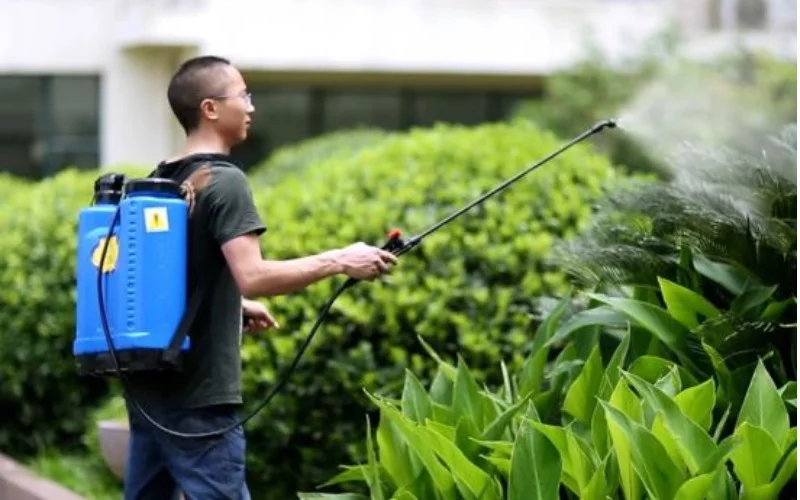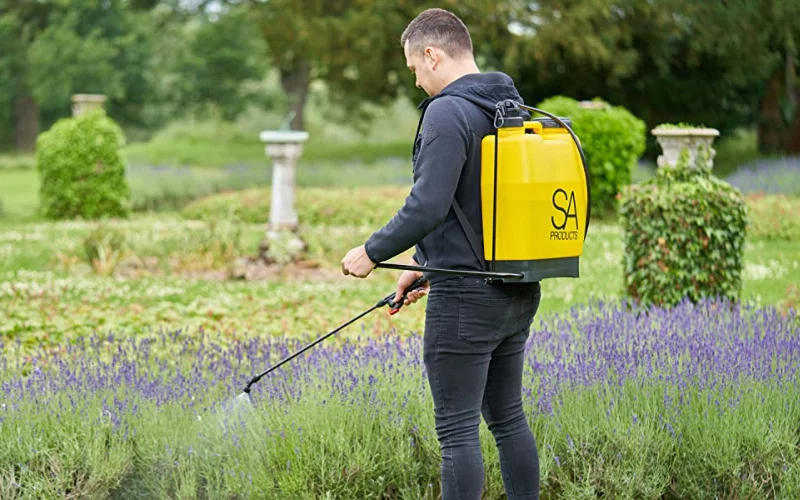If you are a homeowner or a gardener, you certainly know the amount of work it takes to keep your lawn and garden looking lush, and anything that will ease this chore even a little is most welcome. A backpack sprayer is one of those tools that ease your work, even if it’s just slightly.
A backpack reduces the stress of spraying your garden with a manual pump or spray bottle, especially if you have a large expanse of land.
How far a backyard sprayer will spray will tell you how much time you will have to spend spraying the land. The farther, the better. A backpack, on average, can cover 20 feet, given the right nozzle and pressure.
How Does a Backpack Sprayer Work?
Whenever we hear backpacks, our minds go to the bags students take to school to carry their books and other stuff. Still, backpack sprayers are standard spray application tools that can be carried like a student’s backpack or just for applying the different liquid products on a lawn, garden, or small farms.
A backpack sprayer usually works battery-operated or pumped up by hand to build pressure that lets the liquid flow from the container through the spray unit, which determines the speed and direction of spray.
The container has an opening at the top where you pour the liquid you wish to spray. Then a small battery-operated system provides the pressure that forces the liquid into the spray nozzle.
The hand-operated units still work in the same way, only that you must apply the pressure by pumping the backpack yourself.
Why Use Backpack Sprayer?

There are many reasons why backpacks are becoming more popular among gardeners and homeowners. One of them is the fact many of the products that are used on lawns and gardens come in concentrated form, which needs to be diluted and applied as a liquid, stuff as liquid fertilizers, weed killers, pesticides, and the likes, and a backpack is an ideal tool for that kind of job.
The fact that you can easily carry your backpack on your back as you spray your lawn or garden means you have less weight of the backpack to carry since gravity helps make the weight lighter.
Secondly, it offers the convenience of doing the chore since one of your hands is free while the other holds the sprayer.
Most backpack sprayers can hold more than a gallon of liquid, so you can spray a large area of land before you refill and continue the chore. This helps reduce the stress and time it takes to get the job done.
How Far Will a Backpack Sprayer Spray?
There are 2 main determinants of how far your backpack sprayer will go: the nozzle type and its pressure. They affect the spread, the amount of spray an area gets the uniformity of spray and even the amount of drift that occurs.
This is so because each nozzle has a given pressure it works with, and they are designed especially for use under certain application conditions.
The higher the pressure of a backpack sprayer, the farther it can travel; the nozzle can help modify this pressure. Most backpack sprayers, especially the motorized versions, can spray a distance of 10 to 30 feet. But if you want to know the exact distance your unit will travel, you can determine it by its velocity.
The velocity of any object is a measure of the distance it travels over time in a given direction.
Mathematically:
Velocity=distance/time
If you remember your basic arithmetic, you will deduce that :
Distance = velocity × time
You can locate the velocity of your nozzle because it is usually stated on the manufacturer’s manual or the pack, and it is usually measured in “meters per second,” “feet per second,” or “inches per second.”
Since you now know the nozzle, the next thing is to choose some seconds to use for your calculation. You could choose how long it takes for the water from the backpack sprayer to get to the target.
You could choose 4 seconds, for instance, as the time it will take the liquid to move from your sprayer to its destination.
The next thing to do is multiply the machine’s velocity by time. So if the velocity of the unit is 4 feet per second, then you can calculate the distance like this:
Distance= velocity×time
Distance= 4 × 4= 16 feet
Hence that backpack sprayer will cover 16 feet for every spray standing in a given position.
Factors To Consider When Choosing Backpack Sprayer
Before you opt for a backpack sprayer, here are a few things you have to keep in mind:
1. Pressure
The unit for measuring pressure a backpack sprayer can propel through its nozzle is Pounds per unit (psi), and the average psi is 70 psi, while the range is usually 40 to 150 psi.
You need to get the right pressure for the size of the area you will be spraying. Too little pressure leads to an uneven spray of the content, meaning some areas will get more than others. Too much pressure on a small lawn is just a waste.
2. Piston versus Diaphragm
There are 2 types of liquid delivery systems for a backpack sprayer: piston pump and diaphragm pump.
The former works by drawing the liquid from the tank to an enclosed compartment on the upstroke and pushing the liquid out through the outlet nozzle.
This type of pump is home use because of its simple designs and produces a steady, robust and fine droplet application.
The diaphragm pump is your best bet for professional use because it is designed for potent pest control and weed killer chemicals.
This type of pump works by moving liquid from one side of a compartment to the other with a diaphragm, resulting in one side being always full and one side always empty.
3. Manual vs. Motorized
Manual backpack sprayers are those that are hand-operated through a hand pump that is attached to the backpack chamber.
You can use it for small yards or gardens because pumping manually for a long period can cause a lot of pain and fatigue. One of its main selling points is the fact that it is inexpensive.
Motorized backpack sprayers are versatile units that use either gas or batteries; they require no strenuous manual pumping because it automatically pumps the liquid from the backpack chamber to the wand.
These units are meant for large projects and busy professionals. It is too pricey and does not come as a surprise because of its efficiency.
4. The Capacity Of The Tank
Backpack sprayers all come in different tank capacities, but the range is usually 2 to 7 gallons, with the average volume being 4 gallons.
The higher the capacity, the more the stress of logging such a heavy load as you spray your lawn, but the advantage is that you are saved from having to refill like you would if you are using a tank with less capacity.
5. Additional Features
There are a few added features in some backpack sprayers that add value to the unit. For instance, some sprayers have a foldaway pump handle, a foaming nozzle, and extra padding in the shoulder strap for your comfort. These features can affect how you feel as you spray your lawn or garden.
How To Calibrate A Backpack Sprayer
Backpack sprayers are mostly used for applying liquid fertilizers and herbicides for spot treatments, small areas, or home lawns.
You must learn how to calibrate the output of your sprayer so that you don’t overapply these chemicals on your land, which will cause more harm than good, nor underapply them, which will have little or no effect. This is how to calibrate a backpack sprayer:
1. Be sure to read the manufacturer’s manual to know the gallons per acre (GPA) of solution needed for proper application.
2. Ensure that the sprayer and nozzle are clean and working properly because improperly-working sprayers will affect the calibration and application of products.
3. Fill up the backpack sprayer tank with clean water. You never calibrate with chemicals.
4. Then, Walk at a pace you are comfortable with and apply the water in the tank water uniformly to the entire calibration area while recording the time in seconds that is required to completely cover the calibration area with water.
5. You can repeat step 4 above a few times to get an average time it will take to cover the given area.
6. Determine the amount of liquid that was spread on the calibration area when you got from step 5 above, using a container that measures volume in ounces. The amount of liquid ounces you collected equals the sprayer’s application rate in gallons per acre (GPA).
Conclusion
A sprayer is one of the most important tools in the arsenal of a gardener or homeowners who want to keep their lawn and garden prime, there are different types of categories of this tool, and the backpack version is a very version among home users who do not have a large area to spray.
You can calculate the reach of this sprayer but multiplying its velocity, which is always indicated in the backpack manufacturer’s manual, and the time it takes the liquid to flow.
Helpful Links:
- Best Retractable Garden Hose
- What Sprinkler Has the Most Coverage?
- What Is The Most Efficient Sprinkler Head?
- Why Is My Echo Weed Eater Won’t Start
- How To Care For Your Leaf Blower Batteries
We trust this article helped you learn more about how a backpack sprayer works. You may also want to check How To Choose a Pressure Washer Nozzle?
Thanks for taking the time to read our article, and we hope you find it helpful. Would you mind leaving a comment below if you have any suggestions?
Kindly reach out to people by sharing this post on social media.
If you liked this article, then please follow us on Facebook, Instagram, Twitter, and Pinterest.


